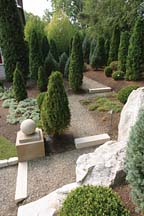
Natural stone played an integral role in the formation of a sophisticated yet soothing garden environment, completing the elegant setting of a private residence located in the suburbs of Detroit, MI. The serene landscape consists of architectural elements fabricated from Bluestone, limestone and quartzite, which were chosen to complement the home's limestone facade and slate roof.
“The clients desired an 'ordered garden', but wanted the edges to be soft and fanciful,†said Jeff Hennig, founder and chief designer of Environmental Artists of Clarkston, MI. “Although the home was grand, it was stark and quite masculine -- requiring the landscape to soften and warm the facade.â€
Hennig explained that Environmental Artists took over the job after it was more than halfway completed. “Typically our firm collaborates with the architect and interior designer early in the design process to integrate the interior and exterior home elements,†he said. “This particular garden posed some challenges, as we were brought into the project after 80% of the home's construction had been completed.†In his design, Hennig incorporated approximately 250 tons of stone into the landscape.
“The client wanted it to be more feminine with lots of flowers, and they also wanted it to be sophisticated,†said the garden builder. “Environmental Artists incorporates the use of stone in all of our gardens. It's amazing; there is more stone than plants in the garden. People ask me all these questions about plants, but I'm more into creating architecture in the garden; the stone grounds it. Clients request for their gardens to be dramatic; stone can be dramatic by being quiet and soulful.â€
Because the majority of the garden design had been in place when Environmental Artists was hired, all of the new content had to be retrofitted into the site, explained Hennig. “It's like an artist starting a painting and then another artist completed it.â€

The layout
The approach to the front of the residence was drastically changed. By removing an existing circular driveway and adding a wall to extend across the front of the home, it allowed for an expansive crushed aggregate stone motor court. “Now the court can accommodate multiple guests to park in the front of the home,†said Hennig. “It's a modular square that is footed by a large alcove wall of Bluestone.â€He continued to explain that rose plantings behind the wall provides whimsicality desired by the clients. At the rear of the home, a cabana was already in place. “It was necessary to design a pool complementing the axial relationship the house had with the existing cabana. Therefore, a simple rectangular pool with a vanishing edge in the back and a rim flow was incorporated.†The rimmed flow was at the same level as the small Bluestone coping around the edge. Reinforcing the axis in the front, numerous Wisconsin Valder flame edged lawn steps were added to create a ruin-like irregularity.â€
According to Hennig, there is also a small terrace with a kitchen garden. “We basically punctuated the site with indigenous material,†said the garden builder, adding that the design favored a European style.
Sections of quartzite -- measuring 3 to 8 tons each -- were placed in the corners of the garden, serving as retaining walls. “The quartzite happened to catch my eye,†said Hennig. “It was complementing to the Bluestone. We used it where we had severe grades, such as at the ends of the walls, sides of the steps and rear of the garden.†The material was quarried from the Great Lakes area in Canada and supplied by DMT Stone of Michigan.
Alcove Bluestone -- supplied by New York Quarries Inc. of Alcove, NY -- was employed in a random pattern for the garden wall. “It is much harder than other Bluestone,†said the garden builder. “The color of the stone is blue to charcoal blue, adding richness and seamlessly complementing the slate roof.â€
The pieces of Bluestone were placed by hand, and some pieces were cut with a saw on site to fit. “The largest design challenge we had with the quartzite outcropping was setting the stone contrary to how it appears in nature,†said Hennig. “Occasionally, we would deliberately set the stone against the grain. Each piece had to be addressed.â€
According to the garden builder, he worked on site and installed a portion of the stonework. “It was fun, and brought back memories -- as I am a product of the field,†he said.
In addition to the quartzite and Bluestone, solid 2- x 2-foot Indiana Buff limestone pillars -- supplied by Dixie Cut Stone of Bridgeport, MI -- were set within the stone wall. Each piece weighs between 2,000 to 3,000 pounds and measures 24 inches square and 36 inches high. A sphere with a diameter of 14 inches was placed on top of each pillar. The spheres were secured by hidden pins and provide the wall with a sense of balance, according to Hennig.
Overall, the entire garden project was constructed in about a year, but installing the stonework didn't require much time. “We were in and out in a couple of days, but were on the job for a year,†said Hennig. “We completed it within one week of the deadline.â€
End box:
Private Residence, Michigan
Garden Builder: Environmental Artists, Clarkston, MIStone Suppliers: Dixie Cut Stone, Bridgeport, MI (limestone pillars); DMT Stone (quartzite); New York Quarries Inc., Alcove, NY (Bluestone); Valders Stone & Marble Inc., Valders, WI (steps)
